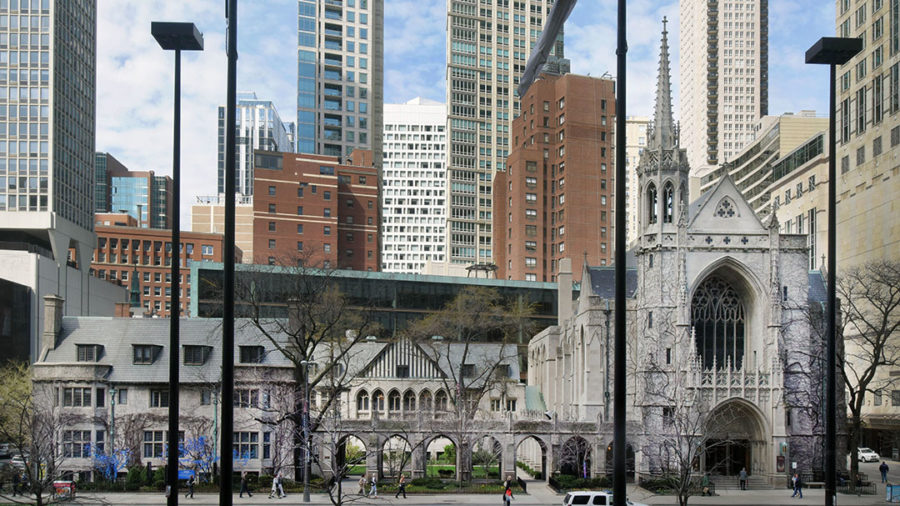The ivy on Fourth Presbyterian Church is still green on the first weekend in October. While leaves on surrounding trees have grown desiccated and begun to drop, the green tendrils on the church’s facade remain lush. The foliage wraps around crevices like the arms of a wool sweater, softening the hard lines of the church’s stone and accentuating the height of its spire. But why, I wondered during my visit to the church in early fall, was the ivy still green? I found my answer across the street: the vines hadn’t yet dried out because they receive very little sunlight.
Fourth Presbyterian Church, or Fourth Church, is the second-oldest building on Michigan Avenue, north of the Chicago River. Finished in 1914, it is a striking neo-Gothic structure on a strip now frequented for modern commodities. The sanctuary neighbors a Bloomingdale’s, a Verizon, and an H&M. A high-rise condominium and Starbucks sit behind the church. The all-black skyscraper, formerly known as the John Hancock Center and now as 875 North Michigan Avenue, looms tall opposite the church’s east-facing facade, as if taunting it. Fourth Church refers to itself as “A Light in the City” on its website. Ironically, it stands today almost exclusively in shade.
This Michigan Avenue location is the third building to house the Fourth Church congregation. Their first church building was destroyed during the Great Chicago Fire in 1871. Their second was a humble stone structure that served the ministry for just over 40 years before the congregation outgrew it. So, in 1912, architect Ralph Adams Cram was commissioned to design the impressive sanctuary that stands today. Cram was then a well-known and prolific architect of collegiate and ecclesiastical buildings, most notably in the Gothic Revival style. Cram’s father was a Unitarian preacher, instilling in the architect an understanding of biblical principles that would feature prominently in the buildings he designed.
When designing Fourth Church, Cram championed art and modernity. According to the Church’s archives, Cram said: “When we build here in America, we are building for now. We are manifesting the living church. It is art, not archaeology, that drives us. From the past, not in the past, the Church should be pure and scholarly Gothic, both modern in feeling and medieval; an enduring style adopted to modern conditions.” In an effort to achieve the modernity he speaks of, Cram incorporated elements of Arts and Crafts architecture—a movement that championed detail and craftsmanship in response to the Industrial Revolution. While his structure remains timeless, it is modernity in its most contemporary form that has caused the Church to be overshadowed—literally.
Still, the building remains striking. Bedford limestone, the same material used to build the Pentagon and Rockefeller Center, peeks out from behind the crawling ivy. An arched tympanum above the church’s wooden doors displays a relief of Moses’s brother Aaron and other biblical figures. Above it, a passage from the Bible known as the Aaronic Blessing is engraved in Gothic lettering: “The Lord bless you and keep thee; the Lord make his face shine upon thee and be gracious unto thee; the Lord lift up his countenance upon thee and give you peace.” In this way, Fourth Church announces itself as a religious institution and a haven for the public who passes it.
The church opens to a grand central hall, or nave. It deviates from typical cruciform Gothic churches where a second hall would intersect the nave to form the image of a cross in the architectural plan. Instead, Fourth Church’s single nave is broken only by large pillars that carve two narrow aisles on either side of the sanctuary. A high, vaulted ceiling carries insulated sound to all corners of the building, while thick stone walls keep out interruptions from Michigan Avenue. All of the church’s pews are situated in this one shared space, creating a sense of intimacy in lieu of great volume. When the priest asks the church to recite a prayer in unison, the diverse voices of parishioners meld into a single chord that booms low and heavy.
The interior details of Fourth Church employ the Arts and Crafts movement most clearly. The floor is laid with earth-toned tiles from Pewabic Pottery, a historic Detroit studio known for its iridescent glazes. The building’s vaulted ceiling is supported by wooden beams, each decorated with turquoise-blue and burnt-orange patterns meant to compliment the floor below. The arrangement of the ceiling’s wooden spine is meant to recall the anatomy of a ship and, though not explicit, likely a reference to Noah and his ark. Intimately familiar with Christian scripture himself, Cram included many such biblical allusions in his design. Decorative angels top every pillar, and between them are stained-glass clerestory windows which, when sufficiently illuminated, display Bible stories.
Fourth Church’s Great East Window, known as the Nettie Fowler McCormick Memorial Window, is prominently visible from both the exterior and the interior of the sanctuary. Inside, brilliant blues and reds create stark contrast with the silhouetted stone from the church’s external facade. Charles J. Connick was the designer and manufacturer of the Great East Window and, like Cram, worked most often in the Gothic Revival style. Despite its many apertures, the sanctuary appears more efficiently lit during the evening hours when several fixtures offer manufactured warm light than during daylight hours when indirect sunlight reflects dimly off the cool-toned stonework.
Though it may be dim inside Fourth Presbyterian Church, it is not dull. More than 1,000 people file into the 10 a.m. service each Sunday morning. Pedestrians break stride while toting shopping bags or briefcases to gaze at the church’s grandiosity. Tourists take photos. Children look up and point. Ushers stand in business dress outside the church doors to welcome visitors. Fourth Presbyterian Church may not be “A Light in the City” in a literal sense, but it still beckons attention. As is engraved above the Church’s doors: “The Master is here, and calleth to thee.”








